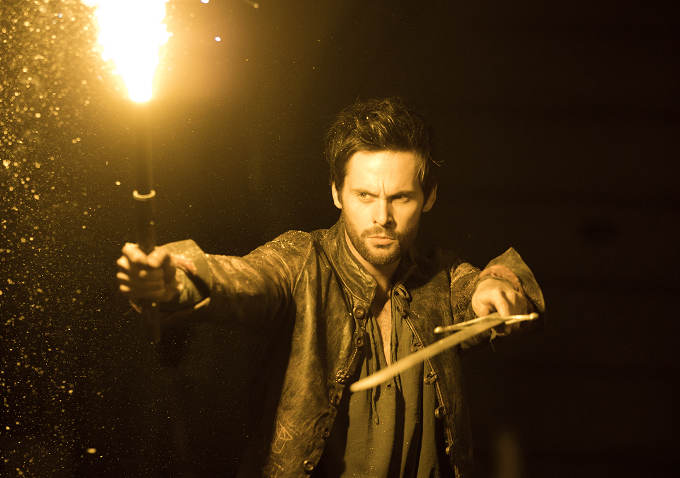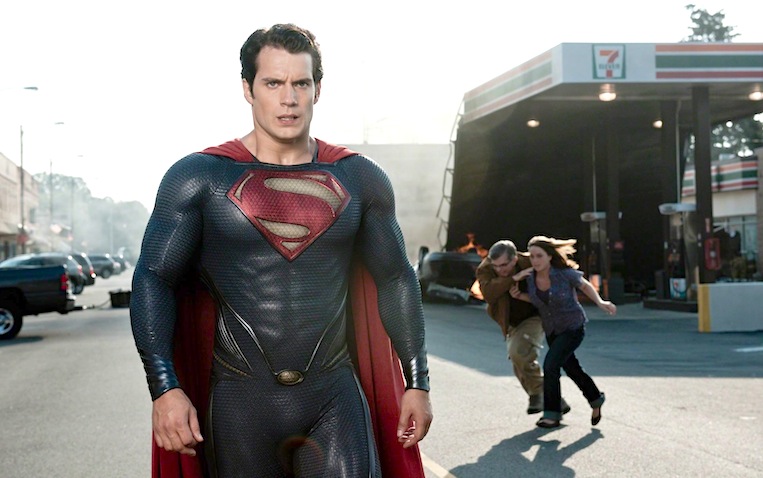By providing your information, you agree to our Terms of Use and our Privacy Policy. We use vendors that may also process your information to help provide our services. This site is protected by reCAPTCHA Enterprise and the Google Privacy Policy and Terms of Service apply.
David S. Goyer on ‘Da Vinci’s Demons,’ Batman and Why Second Acts are the Hardest to Write


David S. Goyer has made a career telling superheroes‘ tall tales. The writer of “Man of Steel,” all three “Blade” films, and co-writer of “Batman Begins,” Goyer also had a hand in “The Dark Knight” and “The Dark Knight Rises” as well as the short-lived “Blade” television show and “Nick Fury: Agent of Shield” TV movie. So, at first, it was somewhat surprising when the Michigan native signed on to create and be the showrunner of “Da Vinci’s Demons” a few years back. Why not a superhero show, if he was going to write for television again? Heading into the season two premiere this Saturday, March 22 at 9pm on Starz, Indiewire sat down with Goyer to discuss his attraction to heroic figures, the differences between writing for movies and TV, and why Iron Man and Batman wouldn’t exist without Leonardo Da Vinci.
Going back to the beginning, what first attracted you to Da Vinci as a character?
I was approached by Starz and Adjacent to see if I’d be interested in meeting with them about doing a TV show, and specifically to see if I’d be interested in doing something historically based. They were envisioning doing something that was a foreign co-production and things that are historically based tend to do well across the world.
I had never done anything that was a period piece before, so that as an exercise seemed really interesting to me. So we started talking about historical figures. I remember we mentioned Tesla, Cleopatra and Da Vinci, maybe a few others. As soon as Da Vinci was mentioned, I went online and saw he’s the most recognized figure in history other than Christ. So I said, “Well, sounds like he’s the guy we should do a show about.”
Sounds like a pretty good basis to start a property.
Just in terms of pre-existing awareness.

But after that initial, commercial appeal of having him be pretty well-known, you fleshed out a distinct personality for this guy. Where did that come from?
From research. People think of Leonardo Da Vinci as this sort of professorial bearded figure who painted “The Last Supper” and the “Mona Lisa.” If you drill down a little further, you see he’s a guy who invented some crazy inventions. But if you read his actual notebooks — at least the pages that are still existing — you get a pretty good sense of his character, and then there were a lot of other contemporaries at the time who were writing about him.
He was a fascinating, mercurial character. He was a bit of a braggart. He clearly had a chip on his shoulder because he felt he should’ve gotten more respect and credit for the things he’d done. He clearly was a dilettante, a procrastinator, a practical joker. He had a sense of humor. He published a book of jokes during his lifetime. He was bisexual. He was arrested twice and put on trial. All these things, you just think, “My God. This guy had enough crazy things in his life to base 10 shows on.”
It’s really how you fit it all in, and he came in contact with a lot of interesting people at the time, from Machiavelli to Borgia. He was also kind of a jerk, in the way a lot of geniuses are. He was selfish, and he had feuds. He was a friend of Botticelli’s, but he was dismissive of his artwork. If we get there — this would probably be in season four or five — he and Michelangelo hated each other. They got in fistfights! I think that’s fascinating as well. He was not this dry, kind of beard-stroking guy. He was this vibrant, bigger than life character.
It seems like a lot of the characters you’ve worked with in the past — Superman, Batman, Blade — are these strong, central figures. These are all superheroes, and Da Vinci’s brilliance was even treated like a superhuman ability. What appeals to you about these kind of characters?

People have said, “Are you trying to turn Da Vinci into a superhero?” And I’m not, but I do think he’s a mythic figure. If you look at the way Da Vinci sits in the public consciousness, he really has become this mythologized Paul Bunyan-type figure. Even contemporary biographies at the time — this one guy, Vasari — said he could bend iron bars with his bare hands and that he would go into the mountains and wrestle with bears. I’m not making that up. That’s what his contemporary biographer said.
Clearly that’s not true, but the fact that people were telling tall tales about Da Vinci even while he lived — he was the model for Tony Stark. Bob Kane has said that he based the design of Batman’s cape on Da Vinci’s ornithopter. So it’s not that much of a leap going from Batman back to Da Vinci. And Da Vinci literally was the model for the renaissance man. That’s a very Nietzsche and Superman-like figure as well. I actually didn’t think it was a leap.
Right, but why make the leap, I guess, was my question.
I was immersed in comic books and hero figures when I was a kid. I just like writing about them. I don’t know. I like writing about bigger than life characters, and I particularly like writing about characters that have really big responsibilities foisted on them. I mean, clearly, if you look at the stuff I’ve worked on.
“Man of Steel,” obviously.
“Man of Steel.” “Batman.” Even “Blade.” It’s also interesting they all — thinking about Blade, Da Vinci, Batman and Superman — they all have father issues, too. [publicist – “We’ll leave it at that”] Yeah. No, I had father issues. That’s fine.

Well, looking at your history a little bit, you’ve worked extensively in both TV and film. How do you tell your stories differently in the two mediums — for instance, setting up characters for a film franchise as opposed to setting up characters in a series?
“Da Vinci” is a serialized show, and I tend to like serialized shows. I would liken the first season of “Da Vinci” to the first act in a movie. It’s the set up. It’s the origin. Seasons two — and three, if we get there — are like a second act in a film. In some ways, the first act is a lot easier to write. It’s all set up and cool stuff and no consequences. You don’t have to sew up any plot lines, and that’s sort of what we were able to do with the first season of “Da Vinci.”
What’s difficult when you get into the second season is, “Now I actually have to start answering some questions.” You know, I can’t just say, “And then this happens.” The second act of the film is by far the hardest thing to write. It’s where a lot of movies and screenplays bog down and I think that a lot of shows stumble in their second season. The second season is the quickening — where the show either finds its footing or it fails.
Do you have an overarching plan as to where this is going?
I have a general plan, but there are a lot of places where the specifics aren’t worked out. Season two largely follows the plan we set out at the beginning, and even the general plan I had in season one, but I will say that — without giving too much away — an event that happens at the end of season two, I had originally conceived of happening at the end of season three. I made an impulsive decision to pull it forward, and hopefully it won’t bite me in the ass.
Did you direct any of season two, and are you planning to come back and direct at all?

I directed some second unit for season two. I didn’t direct whole episodes, in part because, unfortunately, the start of our principal photography completely coincided with a month-long press tour for “Man of Steel.” Look, I wrote the season document for season two. I co-wrote a couple of the episodes, and I was the showrunner. I wasn’t in Wales as much as I was for season one, but I also didn’t need to be because the show was up and running. Certain aspects kind of run themselves. I would love to go back and direct some episodes for season three, if there is a season three. I will say the show’s settled into a rhythm now, which is very nice.
So do you feel better about season two than season one?
I do. I was very happy with season one by the end of it. Season one was one of the hardest — if not the hardest — thing I’ve ever had to do, but, by the end of it, I was really, really happy. One anxiety I had when going into season two was whether or not we could top it. Whether or not we would jump the shark or peter out or something like that. I genuinely feel like we topped season one with season two.
Did that fear factor in at all in your decision to move up the planned conclusion from season three to season two?
No. That was something I decided in the end. We wrote the first eight episodes of season two before we started shooting, and then we shot for a while and had a couple of cuts for the episodes. We had outlines for episodes nine and 10, but we didn’t write the scripts because I wanted to see what we were doing and then possibly make some adjustments. That was when we saw the first maybe three episodes and decided to pull this other event forward, but we were really happy to see what we had so far.
You’re the co-writer and producer of NBC’s upcoming “Constantine” pilot. Is there anything you can tell us about it?
It starts shooting next week [at the time of the interview — around March 12]. We announced [the lead] and three other cast members. We’ve got four series regular and have announced them all now. Harold Perrineau, from “Lost,” has joined us which is awesome. Charles Halford who plays Reginald Ledoux on “True Detective” has joined us. That was awesome. Matt Ryan is playing Constantine. I’m very excited. I think it’s going to be good. Neil Marshall, who directed “The Descent” and “Game of Thrones” is directing the pilot. He’s great. I’m heading to Atlanta […]. That’s where we’re shooting it.
By providing your information, you agree to our Terms of Use and our Privacy Policy. We use vendors that may also process your information to help provide our services. This site is protected by reCAPTCHA Enterprise and the Google Privacy Policy and Terms of Service apply.

















